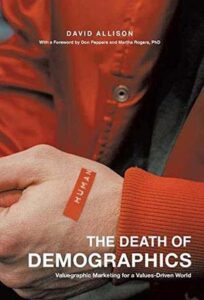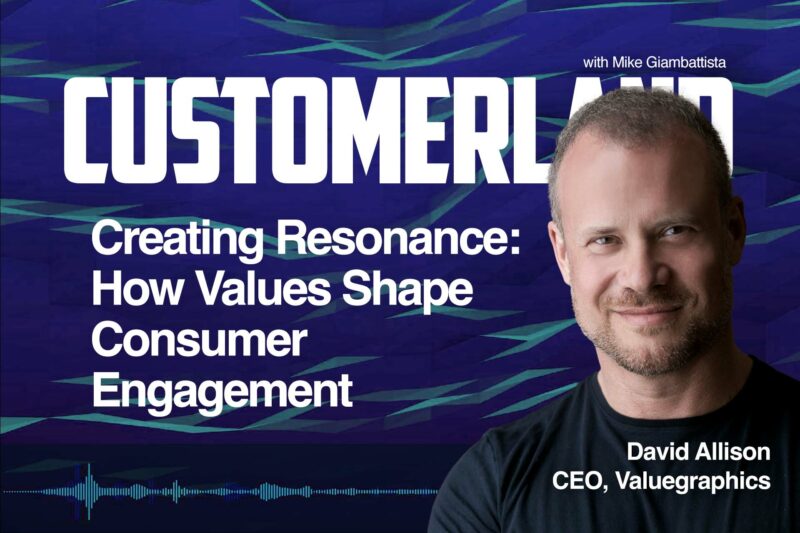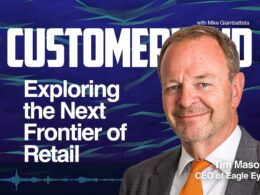Unlock the power of values in marketing. Join us on this enlightening journey with our guest, David Allison, founder and CEO of Valuegraphics. David passionately shares how his company uses data to comprehend the values of potential consumers, helping businesses create effective and standout campaigns. He reveals how understanding these values can help marketers create campaigns that resonate with their target audiences. But that’s not all; this data can help companies identify their unique selling propositions and set themselves apart from the competition.
Ever wondered how your values drive your decisions? We’ll explore this intriguing phenomenon, taking a deep-dive into the mysteries of the brain. We examine the role of the insula – a part of the prefrontal cortex – in filtering information based on our values. How do emotions influence decision-making? We answer this and more, discussing why converting values into data is crucial. Trust us; this understanding can be a game-changer for marketers in our KPI-driven world.
You can check out David’s latest book, “The Death of Demographics” here.

Read the full transcript below
Mike Giambattista
David Allison is founder and CEO of Valuegraphics. If you’re not familiar with David’s work, we’re going to have him explain it, rather than me to a lousy job of that. But first, david, thanks for this conversation. I’ve been looking forward to it ever since you and I first connected a month or two ago, and having spent a little bit more time digging into what you do, I’m even more fascinated. So maybe a few minutes on. What is Valuegraphics? What do you guys do for a living?
David Allison
Sure, thank you for that very kind introduction and thanks for having me over Nice place. You got here, oh, thanks. Yeah, what is Valuegraphics and what do we do? Well, I think it’s important to start by explaining that I began all of this as a marketer and with frustration, with great frustration around some of the basic core tenants and fundamental principles of what it is to do marketing, which is primarily to begin every project by understanding who you’re trying to target. So who are we doing this thing for? No matter what kind of marketing function you’re talking about, you got to at some point sit down and say who’s this for and try to get your head around them. So I had a marketing company and we did this over and over and over again, and the company I had was very specialized in helping large scale real estate developers sell their condos, lease their apartments, their resort communities or whatever it is they’re building, which is actually a really great way to see how marketing works, because each one of those projects has a beginning and a middle and an end, because you target some folks, you can sell them some stuff and within a couple of years it’s done. You get to meet them and see, you know you’re at the ribbon cutting and there you go. So we did this over and over again and every single time the same thing happened.
The people who came and who bought and who responded to our marketing campaigns were not the people that we had targeted. I mean, there was some small percentage where there’s maybe 10 or 15% of the people in the room that ribbon cutting with a shrimp on a stick and a glass of cheap champagne. I’d look around the room and go, okay, so the 10% of you make sense. That’s who we targeted. But who are all the rest of you? And why are you here? We didn’t talk to you, we didn’t create ads for you, we didn’t buy anything in your channels, we didn’t do anything. And yet 90% of the people in the room here you are for some reason and you don’t match this target audience description at all. So that’s kind of the impetus for this was to see if we couldn’t figure that out and fast forward.
A million surveys around the world in 152 languages across 180 countries. We’ve created this data set that tracks what people’s values are, because values this is a neurological fact values drive every decision that everyone makes. So the reason all those people were in the room. They all had the same values. We didn’t know we were triggering those values because we didn’t have this data set. We were accidentally saying stuff and doing stuff that was attracting a group of people who, despite what I could see, I could look around the room and they didn’t resemble each other on the inside, where they make their decisions, they were identical to each other. They were all there for the same set of values. So that’s what value?
Mike Giambattista
graphics is. Were you able to uncover, maybe after the fact, what those commonalities were? Or is that what Valuegraphics became? Trying to understand that.
David Allison
Yeah, because it varies from one thing to another. In fact, if we stay in the world of real estate for a second, I mean we’re used this product out of this data for all kinds of different industries.
But we can do two different, let’s say, condominium towers a couple of blocks away from each other that are very similar in terms of price point and all those other sorts of things, but for some reason there will be some people who are attracted to one of them and they’re slightly different values than the ones who are attracted to the other one down the street. So it’s a great tool to help you understand how to differentiate, because not just in real estate but in everything, it’s always about how much risk are you willing to take to be different. Marketing’s about how am I going to carve out my USP, how am I going to have the unique thing that makes people attracted to my brand? But it’s a risk to be too unique. Everybody else in your competitive set is doing things in a certain way and they’re being kind of successful, and you’re going to be the one who’s going to bust out and do something crazy and kooky just on a whim or a couple of surveys you sent out. It isn’t a logical thing to do unless you have data that says that’s going to work, because this is what people value and they will gravitate towards that thing because it aligns with their values. So it makes it possible to be different and to be unique and carve out a USP in a way that doesn’t have that small P political capital required in order to be the one who makes the call and says let’s go do that thing. I’m rambling already. Here we go. We’ve only just started talking, but welcome to Planet David.
The thing that comes to mind on this subject is the recent controversy over Bud Light and their support of a member of the trans community. Now I’m scared, frankly, that companies are going to look at that backlash and say, well, we can’t be doing anything, to subdued we don’t like. Let’s just stick to our knitting and not try and do anything to help anybody do anything anymore, because look what can happen. It’s too risky. But I think we’re looking at the wrong lesson from that. I think the lesson to take away from that is they chose the wrong thing. Some companies probably should be supporting the trans community and others maybe it doesn’t align with the values of their customers and shouldn’t. So if you know the values of the people that you’re trying to engage and motivate and inspire, you can choose your ESG initiatives or your DEIB initiatives in a way that’s going to win you kudos and applause instead of a Twitter storm of hate. So I think that’s a yeah okay. Well, I’m going to stop there. We’re all in a place right here.
Mike Giambattista
So I’ll, no, no, no. That’s what I love about these conversations, so I’m going to boil that down into my language and say that your takeaway from the Bud Light mess was that had one had Bud Light really understood the values of their customers, they might have chosen a different approach. But two that brands shouldn’t look to throw out the baby with the bathwater, so to speak, but instead should look at the values of their customers and craft messaging accordingly, instead of man and all.
David Allison
Yeah, not all causes, not all good things are for all brands. You know, during Gay Pride Month, every brand is like okay, we’re all about. We’re all about supporting the LGBTQ plus community, and all year long, every company on the earth is saying oh, we’re all environmental and we’re very much about sustainability. That’s two things. There’s a billion things that need help in the world. There’s no shortage of places where organizations can make a difference and do good work. And why not do it in a way that aligns with the values of the people that you’re trying to engage and create community with?
Mike Giambattista
So let me, just for my own sake here, help me frame this up, because there are loads of factors that go into Human decision-making and they’re complicated, and some of them are rational this much and some of them are emotional this much. So when do values as you work with them, fit in that and I even know if it’s a spectrum or continuum or a stack or whatever when, how do values fit in that that overall sense of there’s a billion factors at play here?
David Allison
Yeah, well, values are kind of the source code for all that other stuff. If you look at behavioral science and you dig deep into what smart, smart researchers have been looking at for decades now and you look at, you know, psychology and sociology and neurology and all these different fields that study, how do people make decisions? They fight like cats and dogs about most stuff because they’re, all you know, have their own particular entry point into the conversation, but they do all agree on one core principle and that’s that our values Drive every decision that we make. They’re also the source for our emotions, they’re the source for our feelings. They’re the source for Everything that human experience is about begins with. Is this aligned with my values or isn’t it? And you can, you know, talk about any one of those fields. Let’s look at neurology, because it’s really quite fascinating.
Inside your prefrontal cortex, which we’ve all heard about ad nauseam, there’s a little piece called the insula, and the insula’s job is to take a look at all the incoming data, all the sites and sounds and spells and memories and Past experiences and everything, and go all right. What are we going to do in this particular situation if we do this? What’s going to happen if we do that? What’s going to happen? And the insula uses one set of filters to make that call, and that’s your values. So we think about that for a second and saying all right, let’s say Family is a really, really important value in your particular values makeup it’s not for everybody, but it is for many people and something comes along that’d be great for your family. Your insula is going to say go, get that thing. We want that, and when you get it I’ll reward you. I’m going to make you feel happy, I’m going to give you some joy, I’m going to give you a little bit of contentment. I’m going to give you a prize for going and getting that thing. And something comes along that might be bad for your family and your insula is going to say yeah, no, that’s got to go. We want that offer radar. We don’t want that anywhere near us. And until you make that happen, I’m going to incent you by making you feel stressed and anxious and maybe even afraid, because this could harm something.
That is one of our core values and that’s the way humans Wake up in the morning and maneuver through their days. Every single thing we do, large and small, whether you know you’re doing it or not. The decision-making process going on inside your brain is based on is this aligned with my values or doesn’t it? Standing in the grocery store, two cans of soup in your hand, one in each hand you’re like which one am I going to buy? You’re not thinking about your values, you’re just chucking one in the grocery cart. But the one that you get chucked into the grocery cart somehow has triggered something for your insula to go, that one’s more aligned with their values than this other one. So values drive everything we do.
The problem with values has always been that they’re subjective and what I call business poetry. We all sit around and choose pretty words and say well, our values are collaboration and connectivity and it’s sustainability. We love that word and it makes everybody feel warm and fuzzy. These are the most powerful forces on earth that drive every decision that every human on the planet is making all day long, and we’re using pretty words to figure out what they are and a robust conversation around a box of donuts in the boardroom and we figure we got our values all sorted out. So we turned values into data and we made the world’s first global inventory of core human values, and it’s more accurate than you need for a PhD from Harvard or Princeton or Yale or wherever you want to go, and it tracks and maps a set of 56 core human values that came out of more than a million or close to a million surveys, and these values are literally the source code for all the other things you mentioned in your question about the stack.
I mean values, and people will talk about how emotions are important to understand for decision making. Sure they are, but why does somebody feel great about a brand or hate a brand, or why does somebody feel happy today or sad today? It’s all about whether or not they’re in alignment with their values. And emotions are useful, because I would put that into a category of psychographic information, but emotions change minute by minute. I could be absolutely in love with my Nike sneakers and think Nike’s the best brand in the world and give them a huge rating on an emotional brand index, and then the next day somebody at Nike went in to get my because there’s a problem and they treated me, and now I hate them because they were mean to me in the store or I saw an ad it in like or whatever. My emotions change all day, every day.
My past behavior is a way we can look at how people make decisions. We track how many times has somebody bought this brand before. How many times a month do they buy this brand? What are they? You know, all that kind of past behavior information Again, more psychographic information. But just because I bought a pair of shoes last week doesn’t mean I’m going to buy a pair of shoes next week. It’s not. It’s not useful as a predictive tool. It’s, it gives you some hints, but it doesn’t really say what’s going to happen next. So in order to understand what’s going to happen next, you got to have the values added into that mix.
Sponsor Announcement
I want to take a quick break from the conversation to tell you about one of our sponsors. What could you achieve if you knew what your customers expected ahead of time? What if you could know what customers expect by category and by brand, 12 to 18 months ahead of traditional brand tracking methods? And what if you could know exactly where to adjust and where to spend in order to drive the most benefit every time? A customer expectation audit allows you to identify areas that require strategic reinforcement, as well as pinpoint which values will contribute most to an emotional bond with your brand and optimize accordingly. Customerland has partnered with Brand Keys, the world’s oldest loyalty focused consumer research firm, to bring real world customer expectation audits to brands, brand managers, and the CX practitioners everywhere. Want to know where your brand stands and exactly what to do about it – Go to expectationaudit.com and download a sample audit today.
Mike Giambattista
Let me just kind of frame this up this way. Marketers, as you know, one of the primary users of this kind of information. As a category pretty stressed, they have a very short tenure, typically very KPI driven Either make your numbers or you don’t, and there’s an awful lot of stress and tension in that world and your KPIs are oftentimes numbers that aren’t even really set by you. So, knowing what we now know, what I now know and what you have known for some time that values might be something of a North Star for a lot of marketing efforts how do you get marketers to pay attention to that? How do you break into their world with this kind of information? Because it is course setting and certainly could be course correcting for so much that’s going on out there in the marketers world. But how do you do that? What are you saying to marketers to get them to pay attention to this vital new information?
David Allison
Well, there’s only certain kinds of marketers who want to hear this. They have to be open to rethinking some pretty fundamental core principles of what we’ve all been taught in marketing school, which is that demographics somehow tell us who people are. And when we can show data that proves that demographics are a lousy way to understand who people are, then we start to get ears perking up. When we can also show data, that is about how much more people will pay for something that’s aligned with their values on average across all different product categories. By the way, people will pay 12% more for anything that aligns with their values. It’s higher for some product categories and lower for others, but on average about 12%. So I mean.
A great story about that is Oreo cookies. Last year, Oreo cookies made $4 billion around the world. That’s a lot of cookies. I keep using Oreo as an example because it’s my favorite cookie brand and I think one day they’ll hear me talk about it and I’ll get like a lifetime supply of Oreo cookies.
Mike Giambattista
I’m talking to my. Oreo people right now.
David Allison
So they made $4 billion. And if you do the math and say, well, just for changing a couple of phrases on their packaging or rethinking a social platform a little bit, or changing up a bit of messaging to align with the values of Oreo cookie fans, there’s a potential there for a 12% ROI.
What’s 12% on $4 billion? We’re in the like $300 million. And even if it’s half wrong and you only get a 6% bump just for saying a few things and telling people that I know who you are and I got you, I understand your values, why wouldn’t you do that? So the compelling evidence that’s helping marketers glom onto this is that it’s all data. There’s no. Like David thinks, it’s a really good idea and he’s a compelling speaker, it’s no. There’s facts and figures now that can point to how much more effective this is. Let me give you two stats that’ll kind of paint the picture in the biggest possible way.
If we look at all the demographic labels that we’re all used to age, gender, income, marital status, number of kids, education, white color, blue color, pink color, blah, blah, blah all that stuff and around the world, with more than a million surveys and 152 languages we say okay, let’s look at the people who fit into any one of those demographic cohorts, let’s say millennials or Gen Z or men or people who were in $250,000 a year, any category you want, any one of those labels they say. How often do they agree with each other on anything? How similar are they? In other words, how targetable is that cohort? The average across all of them is 10.5%. So, round off, let’s say they’re about 10% similar to each other. So when you say your target audience is Gen Z, who earn $150,000 a year, have a white color education, they’re single but they hope to be married and they’re living in an urban center, that’s taking four or five groups of people who are about 10% similar to each other, stacking them on top of each other with a bigger group who’s about 10% similar to each other, and saying, great, we know who we’re targeting, let’s go spend money, when in fact all you know is what they are.
You don’t know who they are, you don’t know what wakes them up in the middle of the night, you don’t know what they’re driven by, you don’t know what values they’re going to use to make a decision about anything. All you can do is describe them on the outside and that’s why we get so excited, that’s a 90% fail when you think about it. A 10% accuracy for a target audience description is a 90% fail baked right in. And that’s why when we send out a direct marketing piece, when we send out an email campaign and somebody, we get a three and a half or a 4% open rate. We pop the champagne corks because the best it could possibly do is 10%. And that’s if you do it perfectly.
Mike Giambattista
Now, on the other hand Right there, the media buyers and media planners right now are wincing when you say this.
David Allison
Yeah, and it’s true they should win. On the other hand, if we put people in groups based on what their values are, we see an alignment, a cohesion in those cohorts of as high as 89%. So if we take this and talk about it in terms of a budget, if you got a dollar to spend against the target audience and you do it based on demographic profiling, you got about a 10% return on investment. That’s possible. And if you spend that dollar on a value graphic profile, on a value graphic cohort, you got about an 89 cent dollar that you’re spending. So which dollar do you want to spend? Do you want to spend the 10 cent dollar or the 89 cent dollar?
Mike Giambattista
I’m just going to let that one hang in the air for a moment so they can answer that themselves. So I know that you’ve done some work with Google XI. I’m fascinated by their approach to events because, at least lately and I don’t know if this is their historical trend, but lately they’re focusing on a concept called belonging their intent on producing data and insights that will help event planners and themselves as well produce events that create a strong sense of belonging. I know you had something to do with that effort. I’m just wondering if you can talk about that a little bit. You don’t have to say anything proprietary, no use opening up anything that we can’t talk about here. But it seems like a very likely dovetail into your work in values. But how does that translate into belonging? How did Google use those insights? And then, how about from there? How can event planners take those same insights and use them for themselves?
David Allison
I have nothing but respect for all those folks over at Google XI. The charge is being led over there by Megan Henshaw and a compatriot of hers, Claire, who’s at a company called Storycraft Lab, and for the last little while they’ve been doing a lot of work in a lot of places, talking to a lot of people and trying to pin down how do we make events feel more inclusive. How do we make everybody feel at a business event that they belong there? And they settled on. After a lot of qualitative work with a lot of different groups of people, they settled on this notion that it’s about belonging. So fostering belonging is now the goal. How do we figure out how to make events make everyone feel like they belong? Now they’d come to that conclusion on their own and that’s about when I collided with them.
So they had this QOL data and I met them and I was like, oh my God, belonging is one of the 56 values in the Valuegraphics Database, and when we were talking to people around the world about belonging and about all the other values, we also mapped what they mean when they talk about those values. So in the Valuegraphics Database there are 912 different kinds of belonging, hundreds and hundreds of different ways that it manifests for people in different parts of the world and different kinds of people. So we put our heads together and went wow, we should be pushing our data and making a nice you know, make a casserole out of this, because what you guys have learned qualitatively and what we’ve learned quantitatively was this is peanut butter and jam. This is like to totally mix metaphors this is peanut butter and jam in that casserole that I talked about a second ago, and I think we’re going to have to stick to one food group? I think so because a peanut butter and jam casserole doesn’t sound very appetizing at all.
So we built this thing called the Belonging Index. It’s the Valuegraphics Belonging Index, and so event planners can go onto this free site and enter a place in the world where their next event is going to be held and then enter the occupation of the people that are going to be at the event and it will show, from the Valuegraphics Database, what belonging means to, let’s say, European lawyers. Let’s say, that’s who you’re putting an event together for. It says OK for lawyers in Europe to feel like they belong at an event. Here’s the conditions that need to be met.
And then the next stage what it’s going back into the StoryCraft Lab, Naomi’s picking up the keys of the car, driving it from here is to go back out into the world of event planners and say, all right, if these are the conditions that need to be met, how could we do that? What are some concrete ideas and tactics that will make those conditions come to life at an event? And so all of that information is being built into an online resource that will be free for anybody to come and access and figure out how belonging can be brought to life for various groups of people in various places in the world. So this is exactly the kind of work we love doing is helping more and more people see the value in values.














